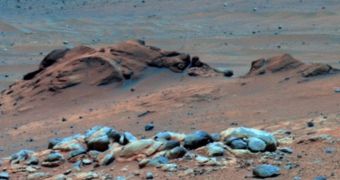Scientists at the Arizona State University (ASU) are proud to announce that one of their instruments was able to detect a very special type of rock on the Red Planet. The Miniature Thermal Emission Spectrometer, or Mini-TES, instrument has been developed at the ASU Mars Space Flight Facility, and it equips both Spirit and Opportunity. The two autonomous robots, part of the Mars Exploration Rover program, carry a Mini-TES each, and the one on Spirit apparently hit jackpot. Though the machine itself is in hibernation now, its studies of the Columbia Hills in the Gusev Crater revealed the existence of carbonate-rich rocks.
The full analysis of the rocky outcrop, now known as Comanche, is currently being published in the June 3 issue of the highly-regarded journal Science. The ASU research team explains that the discovery was made back in 2005, and says that the reason why such a delay occurred between the findings and their publishing is because the instrument that detected the carbonate rocks was “blinded” by dust. The material is a real problem for solar-powered rovers, which rely on winds to clean their solar panels. Otherwise, dust clogs on them, constantly diminishing the amount of available electricity.
“Mini-TES got dusted months before Spirit reached Comanche, and we didn't have a good way to correct for the dust effects at the time. We knew there was something weird about the outcrop's spectrum as seen by Mini-TES, but couldn't say what caused it,” says ASU Mars Space Flight Facility research scientist Steve Ruff, who is also a member of the team that published the Science paper. The lead author of the new investigation was Richard V. Morris, who holds an appointment at the Houston, Texas-based NASA Johnson Space Center. The MER program itself is managed by experts at the space agency's Jet Propulsion Laboratory (JPL), in Pasadena, California.
“Spirit's Mössbauer spectrometer indicated that carbonate was possible, but I didn't believe it. Small amounts of carbonate minerals have been detected on Mars before. [But now,] we're seeing a couple of large outcrops of rock poking through the soil of the Columbia Hills. The rocks are about 25 percent carbonate by weight, by far the highest abundance we've seen on Mars,” Ruff adds. The Mini-TES instruments were designed by the ASU Regents' Professor in the School of Earth and Space Exploration, Philip Christensen. He is the principal investigator of the tools, and a faculty member in the College of Liberal Arts and Sciences at the university.
“This makes the geology harder to understand. It adds another environment to incorporate into the picture of how the Hills formed. The Comanche data have been available to scientists and the public for about four years now. The new finding shows that this data set still harbors potentially major discoveries. Do other surprises await us? Who knows? But I'll make a strong prediction: More discoveries will be made with old data,” Ruff concludes.

 14 DAY TRIAL //
14 DAY TRIAL //